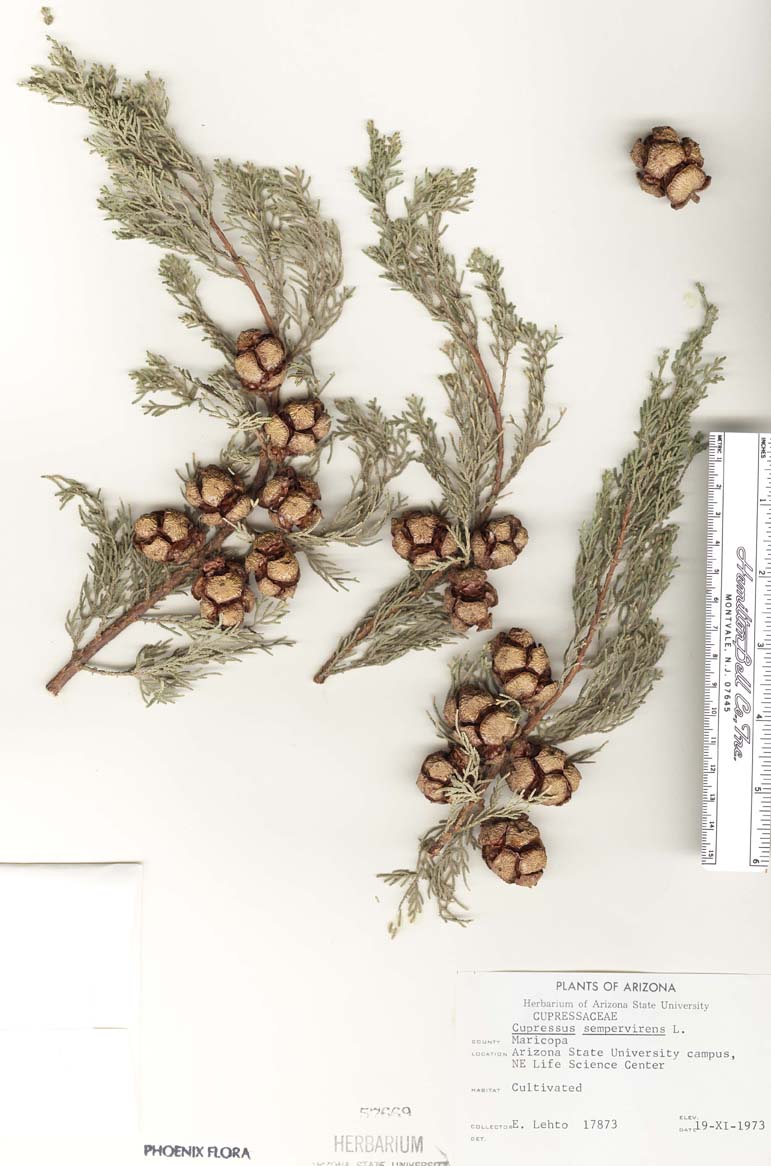Cupressus
|
Family: Cupressaceae |
Trees or large shrubs evergreen. Branchlets terete or quadrangular, in decussate arrays (or partially comblike in Cupressus macnabiana ). Leaves opposite in 4 ranks. Adult leaves appressed to divergent, scalelike, rhomboid, free portion of long-shoot leaves to 4 mm; abaxial gland present or absent. Pollen cones with 4--10 pairs of sporophylls, each sporophyll with 3--10 pollen sacs. Seed cones maturing in 1--2 years, generally persisting closed many years or until opened by fire, globose or oblong, 1--4 cm; scales persistent, 3--6 pairs, valvate, peltate, thick and woody. Seeds 5--20 per scale, lenticular or faceted, narrowly 2-winged; cotyledons 2--5. x = 11. The genus Cupressus in North America consists mainly of small, disjunct, relictual populations, many differing from related populations in color and size of leaves and seeds, activity of leaf glands, glaucousness of various parts, form of growth, and characteristics of bark. Disagreements on the number and rank of taxa reflect these variations. This treatment, with seven taxa, approaches the more conservative end of a spectrum; anywhere from 6 to 15 taxa---species, subspecies, and varieties---might be accepted in the flora. The taxonomy of the genus would benefit from detailed studies of variation in and among populations (cf. J. F. Goggans and C. E. Posey 1968). The Mediterranean Cupressus sempervirens Linnaeus, usually with a fastigiate habit, is commonly cultivated in California, often away from dwellings, but it does not appear to have become naturalized. Other introduced Eurasian and Mexican species are clearly associated with cultivated landscapes.
PLANT: Trees or large shrubs, often pyramidal in youth; monoecious. STEMS: short shoots 4-angled or flat to usually cylindric; in flat sprays or usually arrayed in 3 dimensions. LEAVES decussate, scale-like, closely appressed overlapping. POLLEN CONES: terminal, usually yellow. SEED CONES: terminal, 6-50 mm long, woody, more or less spheric to broad cylindric, maturing first or second year, usually closed more than 2 years; scales 6-12, peltate, abutting, shield or wedge-shaped; scale projection often present, small, pointed, usually less visible with age. SEEDS: 2-many per scale, more or less flat to angled, winged; cotyledons 2-5. NOTES: ca. 22 spp.; w N. Amer, Medit. to e Asia. (Latin name for Cypress). Wolf, C. B. 1948. Aliso 1:1-250. REFERENCES: Bartel, Jim A. 1994. Cupressaceae. J. Ariz. - Nev. Acad. Sci. Volume 27, 195-200. |

